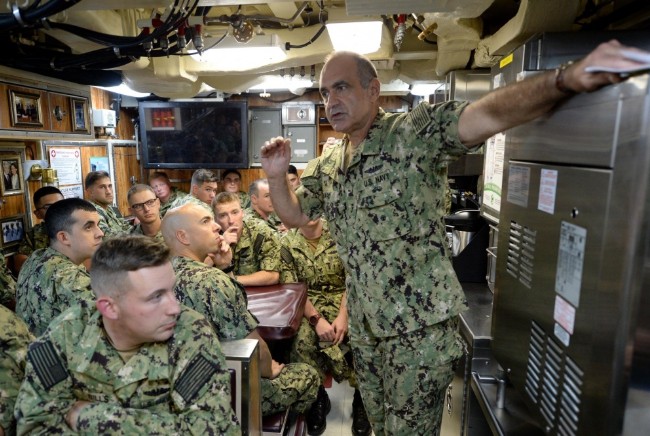
Vice Adm. Chas Richard, the Navy's submarine forces commander who is nominated to lead US Strategic Command, speaks to the crew of USS John Warner (SSN 785) during an all-hands call Aug. 9, 2018. Navy photo by Spc. 1st Class Jeffrey Richardson.
Navy Vice Adm. Chas Richard is looking to be a new leader for a new era at US Strategic Command, one that looks markedly different from the last time STRATCOM changed commanders in 2016.
STRATCOM is now focusing more on its core mission set of nuclear operations and strategic deterrence after other key missions have gained their own dedicated organizations. Under outgoing boss Air Force Gen. John Hyten, US Cyber Command in 2018 moved out from under STRATCOM to become its own unified combatant command. In August, US Space Command stood up and is in the process of transferring those issues and resources out of STRATCOM. US Special Operations Command also took on the task of countering weapons of mass destruction.
If confirmed by the Senate as STRATCOM’s top uniformed officer, Richard will have to consider conventional, nuclear, space, cyberspace, and electromagnetic assets as part of the overall deterrence picture, but without the day-to-day operational responsibilities for some of those areas.
“One of the consequences of these shifts is the gray areas around which command will be responsible for specific programs that have strong connections to both commands,” Senate Armed Services Committee Ranking Member Jack Reed (D-R.I.) said at Richard’s Oct. 24 confirmation hearing. “For example, missile warning satellites, which are integral to our nuclear command and control architecture, are very important and must not be subject to any ambiguity in managing or sustaining them.”
Given those changes, Richard said in written responses to advance policy questions from the committee that he would continue to look at whether the joint force component command structure offers the most effective method to employ STRATCOM’s forces.
“USSTRATCOM’s structure provides a simple, domain-focused warfighting chain of command empowering component commanders to integrate across the joint force to achieve objectives,” Richard wrote. “I agree with USSTRATCOM’s focus to lead through ‘mission-type’ orders and enable component commanders to execute as required.”
STRATCOM and SPACECOM are working together under a memorandum of understanding that allows them to share and transfer space operations responsibilities while the space organization gets up and running.
Richard wrote that SPACECOM, which now handles missile warning and global sensor management, has taken over implementing the findings of the Global Threat Characterization and Assessment Report and tracking those threats. He told lawmakers at the hearing that establishing a separate SPACECOM is “one of the most direct and immediate steps that we can do to ensure nuclear command and control capability [and] adequate warning.”
“I’m particularly encouraged about [SPACECOM boss Gen. Jay] Raymond’s assignment as the sensor commander,” Richard said. “This is the beginnings of us starting to think across individual mission areas and think more broadly—in this case, missile warning, missile defense, and space situational awareness—to optimize this nation’s ability to achieve all of those missions and also do so with an effective use of our resources.”
Richard backs the Pentagon’s plan to modernize its nuclear weapons, aircraft, and submarines. But as the scope of deterrence widens to include more types of offensive capabilities and defenses against new threats, he echoed the 2018 Nuclear Posture Review’s finding that strategic attacks could come from the space and cyber realms.
“There is no cyber or space attack that could have the same strategic effect as a nuclear weapon, including a low-yield nuclear weapon,” Richard said. “Will that be true into the future? I don’t know. Probably not.”
